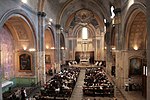Orange, Vaucluse
30s BC establishments35 BCArchaeological sites in FranceCavaresCommunes of Vaucluse ... and 5 more
Orange, VauclusePages with French IPAPages with disabled graphsRoman towns and cities in ProvenceWorld Heritage Sites in France

Orange (French pronunciation: [ɔʁɑ̃ʒ]; Provençal: Aurenja (classical norm) or Aurenjo (Mistralian norm)) is a commune in the Vaucluse department in the Provence-Alpes-Côte d'Azur region in Southeastern France. It is about 21 km (13 mi) north of Avignon, on the departmental border with Gard, which follows the Rhône and also constitutes the regional border with Occitania. Orange is the second-most populated city in Vaucluse, after Avignon.
Excerpt from the Wikipedia article Orange, Vaucluse (License: CC BY-SA 3.0, Authors, Images).Orange, Vaucluse
Boulevard Édouard Daladier, Carpentras
Geographical coordinates (GPS) Address Nearby Places Show on map
Geographical coordinates (GPS)
| Latitude | Longitude |
|---|---|
| N 44.1383 ° | E 4.8097 ° |
Address
Boulevard Édouard Daladier 357
84100 Carpentras, Baron
Provence-Alpes-Côte d'Azur, France
Open on Google Maps










